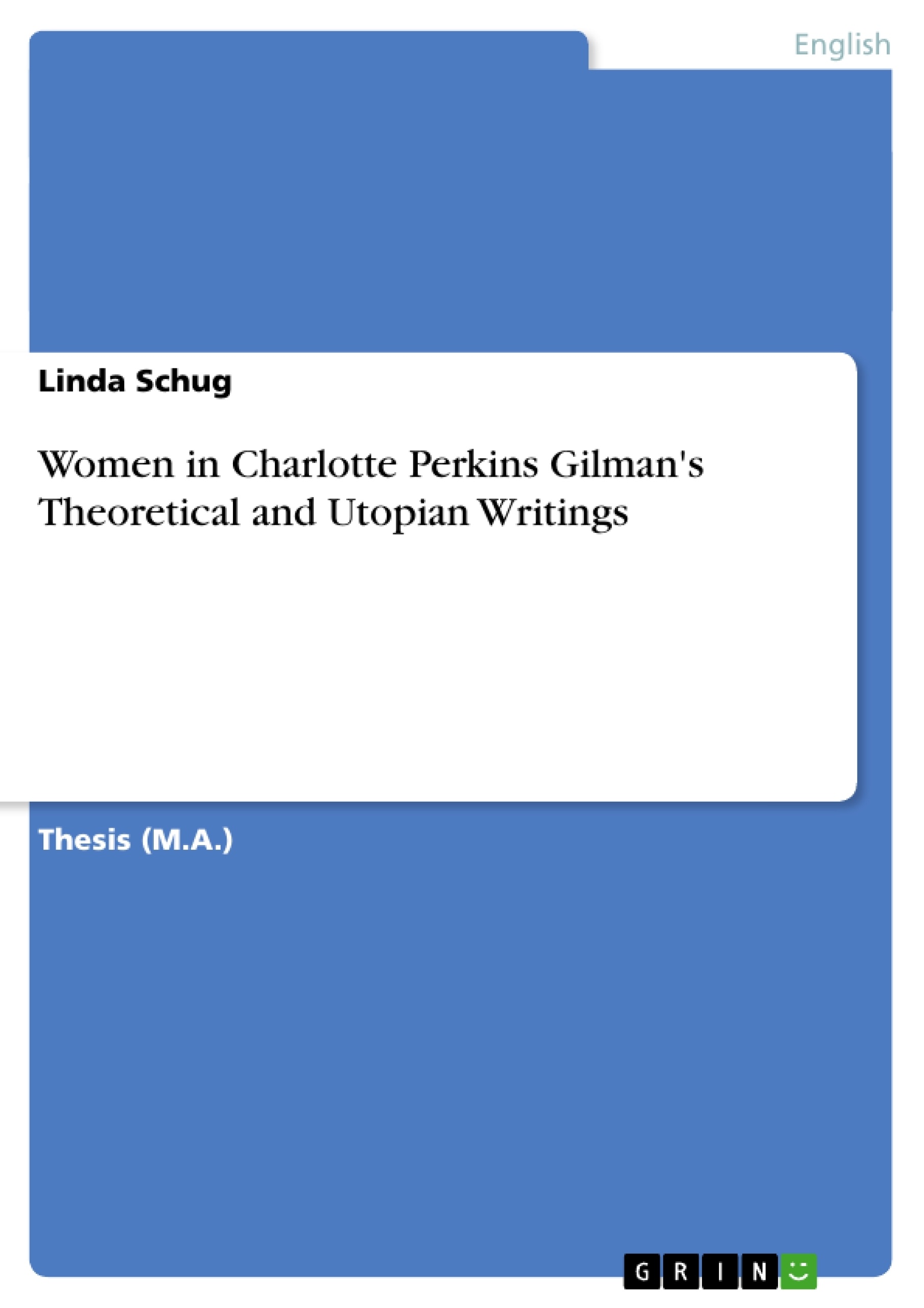[...] Starting with the realistic short fiction, I will show Gilman's main ideas to resolve typical problems of women with the example of some selected stories. I resolved to treat them not in chronological order but to delineate the structural changes in the different levels of social organization that are to be discerned. Moreover I decided to use two narratives in each subdivision because choosing only one would not do justice to the scope of Gilman's imagination and would reduce the findings to be made. So, for example, in both writings of each partition, changes take place in varying degrees and are initiated by different types of characters. The first stories, "Making a Change" and "A Garden of Babies," illustrate the imagined transformation of middle-class women and the betterment of their situation by gainful employment. In addition, "Martha's Mother" and "Forsythe & Forsythe" promote changed living conditions as well. Whereas the next two stories, "Three Thanksgivings" and "Mrs. Hines' Money," describe possibilities of human intercourse and the influence of reform clubs on society, the last pair, "Aunt Mary's Pie Plant" and "Bee Wise," take women's united power to a more utopian extreme and most fully fictionalize the author's theories as short stories.
Similarly, in the fifth chapter, there will be an intensification of Gilman's utopian thinking that is curiously more analogous to the year of publication. The selected pragmatopian novels, The Crux and What Diantha Did, are followed up by the two utopian works, Moving the Mountain and Herland. The sequel of the latter and her last published novel, With Her in Ourland (1916), however, is a dystopia and therefore left out here. In this negative utopia, Gilman mainly criticizes the contemporary situation. It seems to reflect that, as Golden and Knight state, "she lamented the turn of events for women, who, in her opinion, had made little progress toward gaining equality, particularly compared to the widespread transformation she had envisioned for her society and advanced through her theoretical works" (216).
Inhaltsverzeichnis (Table of Contents)
- Introduction
- The Changing Role of Women
- Women Between 1860 and 1890
- The New Woman at the Turn of the Century
- The Flapper in the 1920s
- Women in Gilman's Theoretical Writings
- 'Herstory' and Feminine Characteristics
- Critique on Contemporary Women
- The Ideal Future Woman
- Utopia
- Definition of Utopia
- Definition of Pragmatopia
- Gilman's Literary Aim
- Women in Gilman's Short Stories
- "and therefore they are leaving it" (W 140)
- "Making a Change" (1911)
- "A Garden of Babies" (1909)
- "Every human being needs a home" (W 298)
- "Martha's Mother" (1910)
- "Forsythe & Forsythe" (1913)
- "the whole country is budding into women's clubs" (W 166)
- "Three Thanksgivings" (1909)
- "Mrs. Hines' Money" (1913)
- "women [...] come to their share of this fluent social intercourse"
(W 295)
- "Aunt Mary's Pie Plant" (1908)
- "Bee Wise" (1913)
- "and therefore they are leaving it" (W 140)
- Women in Gilman's Novels
- Pragmatopias
- The Crux (1911)
- What Diantha Did (1910)
- Utopias
- Moving the Mountain (1911)
- Herland (1915)
- Pragmatopias
Zielsetzung und Themenschwerpunkte (Objectives and Key Themes)
This thesis aims to analyze the portrayal of women in Charlotte Perkins Gilman's theoretical and utopian writings. The work examines how Gilman's perspective on women evolved and how it influenced her literary creations. The study explores her critiques of traditional gender roles, her vision for a more equitable society, and the diverse female characters she presents in her utopian novels and short stories.
- The changing roles of women in American society during the late 19th and early 20th centuries.
- Gilman's critiques of contemporary women's roles and her vision for their future.
- The concept of utopia and pragmatopia in Gilman's literary work.
- The female characters in Gilman's utopian literature and their significance.
- The historical context that shaped Gilman's views and writing.
Zusammenfassung der Kapitel (Chapter Summaries)
- The first chapter, "The Changing Role of Women," provides a historical context for Gilman's work. It discusses the evolving role of women in American society between 1860 and 1920, highlighting the shifts in ideals and expectations. The chapter focuses on the ideas of the "New Woman" and the "Flapper," figures who challenged traditional gender norms.
- The second chapter, "Women in Gilman's Theoretical Writings," examines Gilman's feminist theories, particularly her groundbreaking work, "Women and Economics." The chapter explores her critiques of traditional gender roles, her ideas about female characteristics, and her vision for a future society where women have greater economic and social autonomy.
- The third chapter, "Utopia," delves into the concepts of utopia and pragmatopia, providing definitions and exploring Gilman's literary aims in her utopian works. The chapter emphasizes Gilman's intention to use her fiction as a vehicle for social and political commentary.
- The fourth chapter, "Women in Gilman's Short Stories," focuses on the various female characters presented in Gilman's short stories, highlighting their roles and relationships within the narratives. The chapter examines how Gilman utilizes these stories to explore themes of gender, work, family, and societal expectations.
Schlüsselwörter (Keywords)
The key themes and concepts explored in this thesis include women's roles, feminist theory, utopian literature, pragmatopia, gender equality, domesticity, economics, social change, and the historical context of late 19th and early 20th century America.
- Citation du texte
- Linda Schug (Auteur), 2005, Women in Charlotte Perkins Gilman's Theoretical and Utopian Writings, Munich, GRIN Verlag, https://www.grin.com/document/47526



